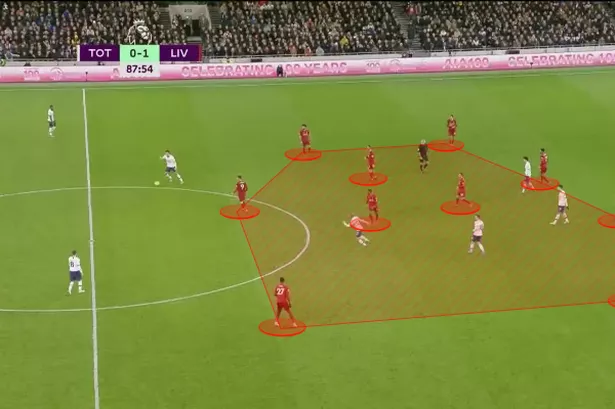
Liverpool form a compact block in the centre of the pitch late in the match with Spurs
87 minutes of football had been played in North London last Saturday, as Jose Mourinho's Tottenham Hotspur clamoured in a desperate search for an equalising goal. Liverpool managed to gain a lead earlier in the contest through Roberto Firmino but had been unable to add to their tally, resulting in the final stages of the match descending into chaos, with ball moving rapidly up and down the pitch, and Spurs missing a pair of excellent chances through Heung-min Son and Giovani Lo Celso.
But in one moment, Liverpool managed to kill Spurs' momentum dead. As Dele Alli took control of possession of the ball near the halfway line, Jürgen Klopp's team morphed into a solid, narrow block and gave their opponents a simple ultimatum - 'go around us'.
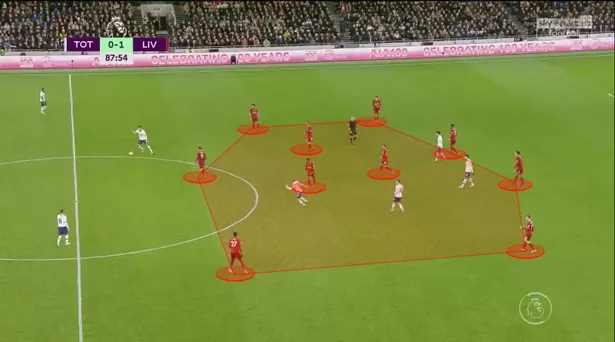
Liverpool form a compact block in the centre of the pitch late in the match with Spurs
10 players wearing red had positioned themselves in the centre of the field, separated from back-to-front and from side-to-side by a total of no more than 20 yards. Unsurprisingly, the ploy worked and the contest ended with Liverpool securing their sixth clean sheet in a row.
The Reds have now conceded at least seven fewer goals than any other Premier League outfit this season, and that record stems from the team's ability to control the pitch. The large majority of football clubs have data analysis departments, but very few, if any at all, incorporate such knowledge into top-level decision-making and processes to the extent that Liverpool do.
Michael Edwards, the club's sporting director, is a former analyst himself having previously spent time at Portsmouth and Spurs. He's since been promoted through the ranks at Anfield, with his current role centred around catering for the medium-to-long term interests of the club as well as ensuring that every department is seamlessly aligned.
Fenway Sports Group, the owners of Liverpool FC, have a history of embracing data. John Henry ventured into baseball before exploring the world of football, and he's renowned for offering Billy Beane, the man behind the concept of Moneyball, a $12.5m deal to become general manager of the Boston Red Sox in 2002. The leading figures on Merseyside have been assembled by FSG over time and are now making a difference to the team's success behind the scenes.
Ian Graham is the director of Liverpool's research division. The Welshman has a doctorate in theoretical physics and believes in evaluating players and wider trends in the sport by crunching sophisticated numbers beneath the surface. Breakthroughs can be made once analysing detail to such a granular level, with the Reds making specific strides in regard to gaining an understanding of what is labelled as pitch control.
Tim Waskett, an astrophysicist, and Will Spearman, who has a doctorate in philosophy, are two members of Liverpool's data science team. Both have spoken publicly about the concept of pitch control, with an example of the type of graphic used to capture the notion pictured below.
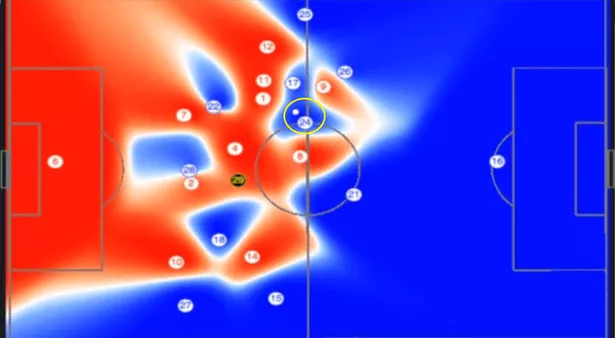
A pitch control visualisation which captures the regions of space controlled by certain players
The player who is circled in yellow has possession of the ball and, essentially, his team has access to the areas of the pitch that are blue, while the red areas are mostly controlled by the opposition. The player is best advised to pass into a teammate positioned within a blue zone.
Waskett has since provided greater context having appeared at the recently held Royal Institution Christmas Lectures. He stated that by combining event data and tracking data, Liverpool can comprehend how each action on the pitch impacts the probability of a goal being scored. One of the graphics that was used to demonstrate that theory can be seen below.
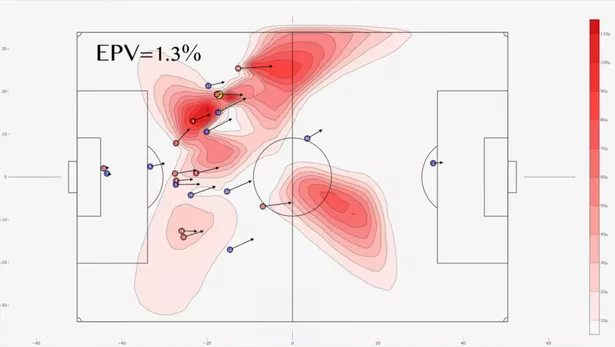
Liverpool's pitch control concept considers which areas of the pitch are best to use at any given time
Waskett stated: "The red team is Liverpool and the areas in red are the places they can get to sooner than the players in blue. Everything is turned into a goal probability and this value, 1.3%, is the probability that a goal will be scored with the ball in this position within the next 15 seconds." Such information is highly complex but once the specifics are filtered and used within the club, the findings can provide a platform for Liverpool to gain an edge over competitors that are yet to develop an awareness.
Klopp is the man responsible for coaching the first-team. Any conclusions that are realised by the club's data science department have to be interpreted and applied in a footballing sense by the Liverpool boss.
The Reds have faced only 55 shots on target in the Premier League this season, which is 10 better than second-best Chelsea on 65, followed by Manchester City on 70. It is possible that Liverpool's defence and the team's dramatic central block late in the match with Spurs stems from the club's appreciation and understanding of pitch control.
On the offensive side of the game, Trent Alexander-Arnold and Andy Robertson are celebrated for passing to one another despite playing on opposite flanks. The actions are somewhat unconventional but again, there's enough reason to suggest that those actions stem from the concept of pitch control and which areas are valued as dangerous. Alexander-Arnold faced Spurs at Anfield earlier in the season and his passing network from the clash is pictured below.
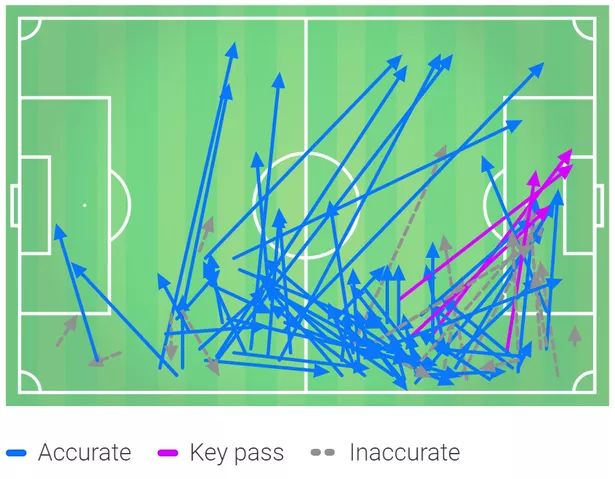
Trent Alexander-Arnold's passing network against Spurs at Anfield (Image: Wyscout)
The sheer volume of diagonal passes that the young full-back made across the field suggests that his actions were deliberately instructed.
Liverpool's midfield has received criticism in recent years because of the general lack of creativity that it tends to employ, but what if pitch control has played a part? Risks in possession are generally taken by the team's full-backs, while Klopp's central midfielders remain disciplined and focus on retaining balance. Perhaps Liverpool's data science department have found the centre of the pitch to be the most crucial to defend, hence players such as Jordan Henderson and Gini Wijnaldum exhibit a preference to play safe.
On the other hand, the inside-right, the inside-left, and the spaces in behind opposing defenders may be considered to be the most effective to use when attacking, rendering the Reds' persistent probing of those areas an intelligent plan.
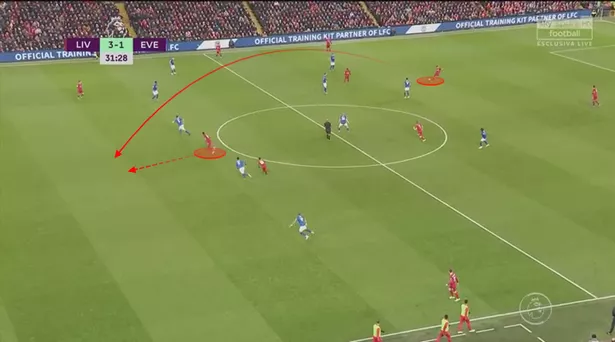
Liverpool score against Everton by hitting a simple long pass over the defence
Nobody knows how much the Reds have actually discovered behind closed doors, but considering the team are world champions and have lost just one Premier League match since May 2018, it is conceivable that the subtle advantages provided by data science are drastically impacting results on the pitch.
The inclusion of data has changed the landscape of other sports but is yet to truly have a revolutionary effect on football. Until that time comes, Liverpool will continue to hold an upper hand over the chasing pack.

